
The Anacardiaceae, commonly known as the cashew family or sumac family, are a family of flowering plants, including about 83 genera with about 860 known species. Members of the Anacardiaceae bear fruits that are drupes and in some cases produce urushiol, an irritant. The Anacardiaceae include numerous genera, several of which are economically important, notably cashew, mango, Chinese lacquer tree, yellow mombin, Peruvian pepper, poison ivy, poison oak, sumac, smoke tree, marula and cuachalalate. The genus Pistacia is now included, but was previously placed in its own family, the Pistaciaceae.
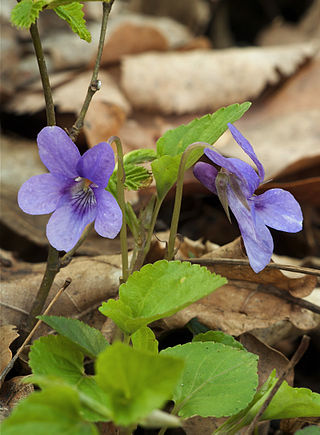
Viola is a genus of flowering plants in the violet family Violaceae. It is the largest genus in the family, containing over 680 species. Most species are found in the temperate Northern Hemisphere; however, some are also found in widely divergent areas such as Hawaii, Australasia, and the Andes.

Cycads are seed plants that typically have a stout and woody (ligneous) trunk with a crown of large, hard, stiff, evergreen and (usually) pinnate leaves. The species are dioecious, that is, individual plants of a species are either male or female. Cycads vary in size from having trunks only a few centimeters to several meters tall. They typically grow very slowly and live very long. Because of their superficial resemblance, they are sometimes mistaken for palms or ferns, but they are not closely related to either group.

Juncaceae is a family of flowering plants, commonly known as the rush family. It consists of 8 genera and about 464 known species of slow-growing, rhizomatous, herbaceous monocotyledonous plants that may superficially resemble grasses and sedges. They often grow on infertile soils in a wide range of moisture conditions. The best-known and largest genus is Juncus. Most of the Juncus species grow exclusively in wetland habitats. A few rushes, such as Juncus bufonius are annuals, but most are perennials.

Juncus is a genus of monocotyledonous flowering plants, commonly known as rushes. It is the largest genus in the family Juncaceae, containing around 300 species.

Juncus effusus is a perennial herbaceous flowering plant species in the rush family Juncaceae, with the common names common rush or soft rush. In North America, the common name soft rush also refers to Juncus interior.

Juncus acutus, the spiny rush, sharp rush or sharp-pointed rush, is a flowering plant in the monocot family Juncaceae. It is native to the Americas, Northern and Southern Africa, Western and Southern Europe and West Asia, and is found in a variety of wet habitats, such as bogs, fens, meadows, and salt marshes, and along the edges of ponds and lakes.
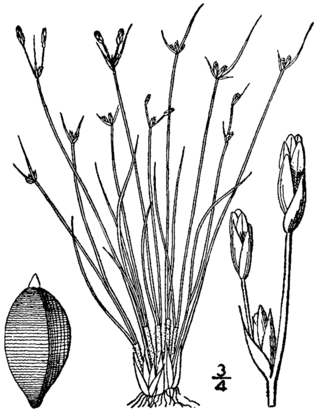
Bulbostylis capillaris is a species of sedge known by the common names densetuft hairsedge and threadleaf beakseed. It is native to much of North America, South America and the West Indies from Canada to Bolivia.
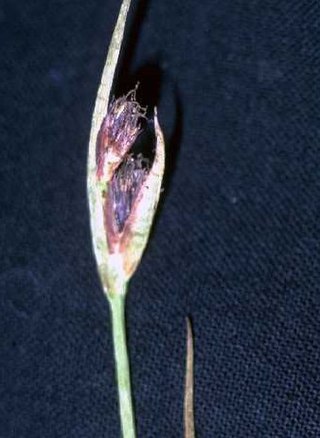
Juncus castaneus is a species of rush known by the common name chestnut rush. It has a circumboreal or circumpolar distribution, occurring throughout the northern latitudes of the Northern Hemisphere. It occurs in Europe, Asia, and North America. In North America it occurs from Alaska to Greenland, its distribution spanning Canada and extending south through the Rocky Mountains in the contiguous United States. It is widespread and common in the Canadian Arctic Archipelago.
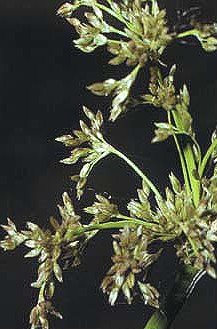
Juncus roemerianus is a species of flowering plant in the rush family known by the common names black rush, needlerush, and black needlerush. It is native to North America, where its main distribution lies along the coastline of the southeastern United States, including the Gulf Coast. It occurs from New Jersey to Texas, with outlying populations in Connecticut, New York, Mexico, and certain Caribbean islands.

Oreojuncus trifidus is a species of rush known by the common names highland rush and three-leaved rush. It is native to the Northern Hemisphere, where it is an arctic/montane species with an amphi-atlantic distribution.

Hypericum undulatum, the wavy St Johns Wort, is a herbaceous perennial flowering plant native to western Europe and northern Africa. The specific name undulatum is Latin, meaning "wavy" or "undulated", referring, just as the common name, to the wavy leaf margins of the herb. The plant has a diploid number of 16 or 32.

Juncus australis is a species of rush known by the common names austral rush, leafless rush and wīwī. The species is native to south-eastern Australia and New Zealand, where it can be found around bodies of water. Its habitat is wet or seasonally wet grasslands and woodlands, and it can grow in dense and damp soil along rivers and creeks. It is a rhizomatous perennial rush that grows up to 120 centimetres tall. The plant flowers in clusters, with dense heads at the tip of the stem.

Juncus filiformis, called the thread rush, is a species of flowering plant in the genus Juncus, with a circumboreal distribution. It has been introduced to South Georgia Island. It is typically found in wetlands, on the borders of lakes and streams.

Juncus inflexus, the hard rush, is a species of flowering plant in the family Juncaceae, native to Europe, Asia and Africa, and introduced in Sri Lanka, Java, Île Amsterdam and Île Saint-Paul, Victoria in Australia, New Zealand, Uruguay, and eastern North America. It is a glycophyte (non-halophyte).
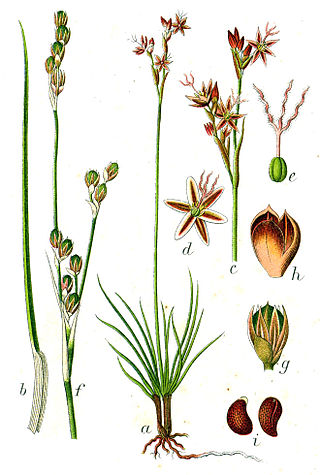
Juncus squarrosus, called goose corn, heath rush, and mosquito rush, is a species of flowering plant in the genus Juncus, native to Iceland, Europe, and Morocco, and introduced to Greenland, Svalbard, Tasmania, New Zealand, and the US state of Wisconsin. It is pollution-tolerant.

Juncus alpinoarticulatus, called the northern green rush and the alpine rush, is a species of flowering plant in the genus Juncus, with a circumboreal distribution. It prefers wet sandy soils, peat bogs, acidic fens, and ditches.
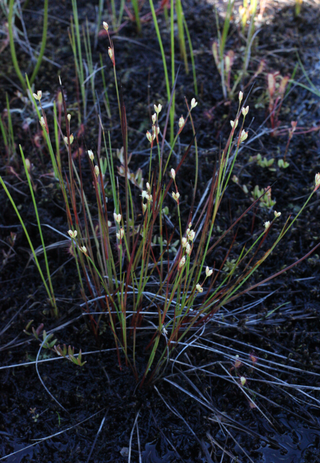
Juncus stygius, called the bog rush and moor rush, is a species of flowering plant in the genus Juncus, with a high circumboreal distribution, never reaching further south than Switzerland, Korea and Upstate New York.
Juncus biglumis, called the two-flowered rush, is a species of flowering plant in the genus Juncus, native to the subarctic and subalpine Northern Hemisphere. It has three divergent genetic lineages that may represent cryptic species.

Juncus canadensis, called the Canadian rush, is a species of flowering plant in the genus Juncus, native to central and eastern Canada and the central and eastern United States, and introduced to Oregon, New Zealand, and the Low Countries in Europe. It is an obligate wetland species.

















